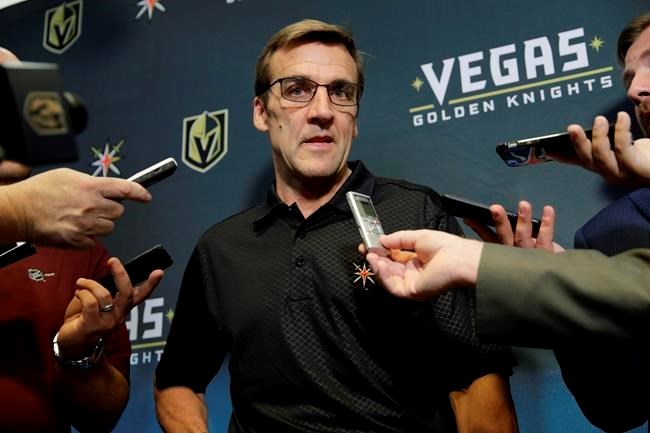When it constructed rules for the upcoming expansion draft, the NHL tried to ensure at least one thing: that the Vegas Golden Knights weren't immediately terrible.
The list of available players to the Knights suggests that might be the case. But in all likelihood, Vegas will lack stars and scoring in the early years of its existence.
"I'm really pleased with what's available," general manager George McPhee said Sunday after protection lists and available players were released.
"This has worked out very well for the Vegas Golden Knights, and we expect to put a good, entertaining club on the ice."
McPhee will be challenged to find ready-made stars to shine on the Vegas strip, especially up front.
Not one all-star from last season is up for grabs, and only one player from the league's top-30 scorers is available: 32-year-old Eric Staal, who resurrected his career with 65 points for Minnesota. Staal is one of only six available players who finished among the top-90 in scoring and one of only 12 to pot at least 20 goals — a group mostly comprised of veteran supporting types like James Neal, Patrick Eaves, T.J. Oshie, and Michael Grabner.
Nobody scored more among available players than the 33-year-old Eaves, who cracked the 20-goal plateau for only the second time with 32 last season.
Offensive upside is relatively limited with first and second year pros exempt from selection.
There are some intriguing talents like 26-year-old Jonathan Marchessault, a 30-goal-scorer last year, 25-year-old Brock Nelson, a three-time 20-goal-man, and Charles Hudon, a Canadiens prospect who scored 27 goals in 56 American Hockey League games last season.
With such a limited pool of top-flight offensive players — especially at centre — the Knights will likely have trouble scoring early just as their three most recent expansion counterparts did.
The first edition Minnesota Wild had zero 20-goal-scorers and were led in scoring by Scott Pellerin with 39 points. The Columbus Blue Jackets debut squad was fronted by Geoff Sanderson, who tallied just 56 points.
Both clubs had strong goaltending though — Manny Fernandez for Minnesota and Ron Tugnutt for Columbus — and started respectably in their first seasons — the Wild ranked 25th overall, the Jackets tied for 22nd.
Likewise, the Knights should be able to come up with a solid stable of netminders and defenders.
Among the goalies available to Vegas: long-time Penguin Marc-Andre Fleury, promising German Philipp Grubauer and one-time Red Wings stud Petr Mrazek.
It's widely expected that Fleury will be the first-time Knights starter, but someone like Grubauer offers real potential for the long-term. The 25-year-old has a .923 save percentage in his first 66 NHL games with numbers last season mirroring Vezina trophy nominee Braden Holtby — albeit as a backup with fewer starts.
McPhee has made it known he won't pick preferred available players if opposing clubs offer up valuable long-term assets. That suggests an understanding of the Knights' mediocrity in the early going and the need for as many potential draft picks and prospects as possible.
The club could help itself further in that regard by selecting young players with untapped upside as opposed to veterans who offer immediate reliability.
The Knights, for example, could look to 30-year-old Adam McQuaid when selecting from Boston or instead choose goaltender Malcolm Subban, a former first round pick coming off a decent year in the American Hockey League. They could select 27-year-old Marco Scandella as a vet for the back-end from Minnesota or choose 22-year-old Matt Dumba, a hard-shooting (and hitting) defender with upside.
"We think we can accomplish two things," McPhee said. "We can put a good team on the ice and accumulate draft picks and be in a surplus situation here in the next couple of years so that we can start with a real good team and then build it with these draft picks to a team that can win a Cup."
Worst-case scenario for Vegas and the NHL is a repeat of the Atlanta Thrashers.
The Thrashers bombed with only 39 points in their first season — last in the league in goals and goals against. Their struggles never subsided and the club was moved to Winnipeg less than 12 years after the first game in Oct. 1999.
Available talent was limited for Atlanta in the 1999 expansion draft as clubs could protect nine forwards, five defencemen, and one goaltender or seven forwards, three defencemen and two goalies.
Hoping to avoid a repeat of Atlanta in Vegas, the NHL mandated the protection of eight skaters and one goalie this time around or seven forwards, three defenders and a goaltender.
"If there's going to be an expansion you want the teams to be a little more competitive than perhaps they've been out of the box," NHL commissioner Gary Bettman said in March 2016. "The notion has been that perhaps in the past if the team isn't competitive enough out of the box there's an initial enthusiasm and then it kind of wanes until the team re-establishes itself."
Jonas Siegel, The Canadian Press
